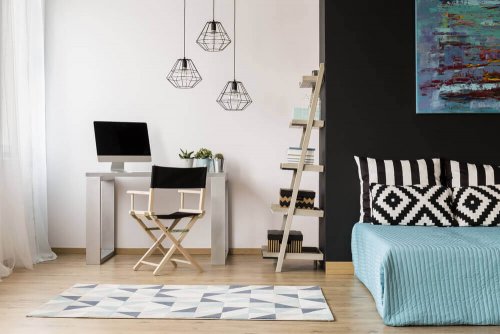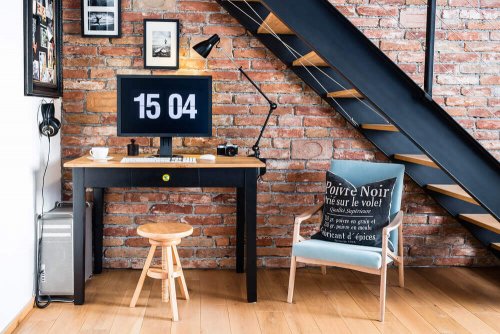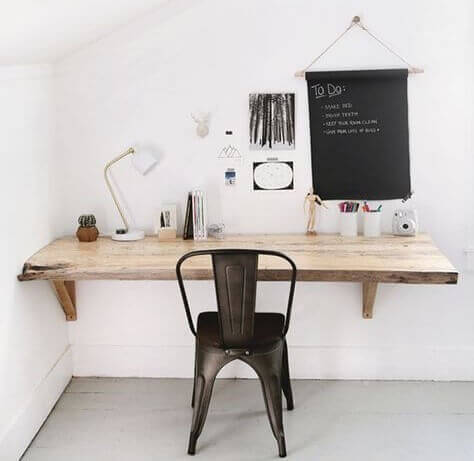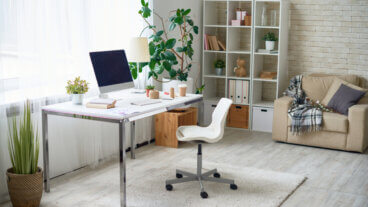How to Design a Well-Organized Study Area

When it comes to designing a well-organized organized study area, it’s best to make sure this is a completely independent room from the other spaces of your home.
Distributing the furniture and the rest of the decorative elements in a clever way will allow you to give this space a peaceful atmosphere that helps you focus on different tasks.
Ideas to help you design a well-organized study area
The most suitable place

Choosing a quiet place that isn’t busy and that, above all, has a lot of natural light is very important. A room of 90 or 110 ft² will be enough for an office or library.
You can set up a small study corner in any room of your house. The living room, a bedroom, or a child’s room are the most suitable options.
Basic accessories
In addition to a work table and chair, if you have a small bookshelf, a desk for your computer, and a storage cabinet with wheels (that you can place under the table), you’ll have a very practical and tidy study area.
Also, to store papers, notebooks, and folders, you should use stackable metal, plastic, or cardboard boxes, as they’re very useful for organizing your work.
A well-lit study area

You’ll need a lamp in your study area. The best option is to use a gooseneck lamp that’s below 100 watts so that it doesn’t affect your vision.
If you’re thinking of putting a desk in your living room or bedroom, choose a table lamp with a lampshade made of fabric or natural fibers that matches the decorative style of the room.
Choosing the table for your well-organized study area
You should opt for tables and desks to put your computer on of about 47x27x29 inches. This will allow you to work more comfortably.
If you want to make the most of the space, you can opt for a corner table that you can make with medium-density fibreboard (MDF) and a sawhorse. Don’t forget to incorporate drawers.
Choose the type of chair
If you work many hours every day, the best thing is for you to use an adjustable ergonomic chair. This will prevent you from suffering from back problems in the long run.
High-back swivel models are very comfortable. Also, we recommended that the seat is about 18 inches from the floor and is about 17 inches wide.
Study areas in difficult spaces

You can create a small, well-organized study area in many difficult corners of your house. Attics, stairwells, and irregularly-shaped hallways, for example.
In these cases, it’s best to order a custom-made piece of furniture, either in wood or in plasterboard. It’s up to you! This solution, in addition to being decorative, allows you to take better advantage of the available space with the divisions that suit you best, either shelves, drawers, or doors.
Create a bookcase
Do you know the most appropriate place to locate a bookcase in a study area? We recommend placing it behind your desk.
This way, your resource books, filing cabinets, and folders will always be on hand and it’ll be more comfortable for you to consult them.
To take advantage of the space, you can place a bookcase that occupies the entire section of the wall closest to your work table. Also, if you paint it in a light color or the same color as the walls, it’ll compliment the space.
Get the color right

Soft colors should feature in your study area. Also, it’s important to avoid overdoing it, both in the painting of the walls as well as the fabrics of the upholstery and curtains.
Overly bold or cold colors don’t promote concentration or work. Instead, you should go for pale yellow or pastel green, since they’re very relaxing colors.
We hope we’ve given you some good ideas so that you can create a well-organized study area. Now all you need to do is design it to suit your personality and style.
When it comes to designing a well-organized organized study area, it’s best to make sure this is a completely independent room from the other spaces of your home.
Distributing the furniture and the rest of the decorative elements in a clever way will allow you to give this space a peaceful atmosphere that helps you focus on different tasks.
Ideas to help you design a well-organized study area
The most suitable place

Choosing a quiet place that isn’t busy and that, above all, has a lot of natural light is very important. A room of 90 or 110 ft² will be enough for an office or library.
You can set up a small study corner in any room of your house. The living room, a bedroom, or a child’s room are the most suitable options.
Basic accessories
In addition to a work table and chair, if you have a small bookshelf, a desk for your computer, and a storage cabinet with wheels (that you can place under the table), you’ll have a very practical and tidy study area.
Also, to store papers, notebooks, and folders, you should use stackable metal, plastic, or cardboard boxes, as they’re very useful for organizing your work.
A well-lit study area

You’ll need a lamp in your study area. The best option is to use a gooseneck lamp that’s below 100 watts so that it doesn’t affect your vision.
If you’re thinking of putting a desk in your living room or bedroom, choose a table lamp with a lampshade made of fabric or natural fibers that matches the decorative style of the room.
Choosing the table for your well-organized study area
You should opt for tables and desks to put your computer on of about 47x27x29 inches. This will allow you to work more comfortably.
If you want to make the most of the space, you can opt for a corner table that you can make with medium-density fibreboard (MDF) and a sawhorse. Don’t forget to incorporate drawers.
Choose the type of chair
If you work many hours every day, the best thing is for you to use an adjustable ergonomic chair. This will prevent you from suffering from back problems in the long run.
High-back swivel models are very comfortable. Also, we recommended that the seat is about 18 inches from the floor and is about 17 inches wide.
Study areas in difficult spaces

You can create a small, well-organized study area in many difficult corners of your house. Attics, stairwells, and irregularly-shaped hallways, for example.
In these cases, it’s best to order a custom-made piece of furniture, either in wood or in plasterboard. It’s up to you! This solution, in addition to being decorative, allows you to take better advantage of the available space with the divisions that suit you best, either shelves, drawers, or doors.
Create a bookcase
Do you know the most appropriate place to locate a bookcase in a study area? We recommend placing it behind your desk.
This way, your resource books, filing cabinets, and folders will always be on hand and it’ll be more comfortable for you to consult them.
To take advantage of the space, you can place a bookcase that occupies the entire section of the wall closest to your work table. Also, if you paint it in a light color or the same color as the walls, it’ll compliment the space.
Get the color right

Soft colors should feature in your study area. Also, it’s important to avoid overdoing it, both in the painting of the walls as well as the fabrics of the upholstery and curtains.
Overly bold or cold colors don’t promote concentration or work. Instead, you should go for pale yellow or pastel green, since they’re very relaxing colors.
We hope we’ve given you some good ideas so that you can create a well-organized study area. Now all you need to do is design it to suit your personality and style.







